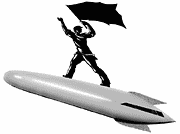DATELINE: SEATTLE. After weeks of intense fighting, Capitol Hill may have gained a strategic advantage over downtown forces in the ongoing post-WTO conflict. For months, the battle line between Capitol Hill militias and Seattle authorities has been at a standstill, with trenches established on both sides of Melrose Avenue.
This stalemate may be broken, how-ever, with Seattle Mayor Paul Schell’s startling announcement that Capitol Hill could have the atomic bomb—confirming many Seattleites’ worst fears. The beleaguered Schell reported that the Capitol Hill Popular Liberation Front (CHPLF) had successfully tested “a really big underground explosive device” near Soap Lake in Eastern Washington. (Livestock deaths and minor property damage were reported; see related story.)
In the preceding weeks, Schell had repeatedly assured nervous residents that the guerrillas did not have nuclear capability. He defended his sudden reversal, saying, “OK, the good news is that it wasn’t an earthquake, and that the insurrection hasn’t affected the NASDAQ.”
On Capitol Hill, a fierce, insular community of some 55,000 residents, anger still lingers over last fall’s four-day WTO conference. Then, Seattle riot police used tear gas, pepper spray, and rubber bullets to push protesters out of the downtown core and into Capitol Hill. Residents were outraged by the disruption, higher rents, and longer movie and restaurant lines caused by this refugee influx and soon took up armed resistance.
On New Year’s Day, insurgent Capitol Hill invaded and occupied Ballard, establishing a strict military curfew. Ballard resistance fighters, drawn from local retirees, briefly resisted this incursion before being distracted by a checkers game. Then, inexplicably, the CHPLF withdrew, citing an absence of good clubs, coffee shops, and boutiques.
Since then, the breakaway neighborhood has been sporadically shelling City Hall and the retail core from the so-called “Bauhaus Heights” region, while National Guard troops have been unwilling to engage the rebels or venture across the Freeway Park “Green Line” where UN peacekeeping troops are stationed.
Speaking at a Seattle press conference, Governor Gary Locke used unusually strong language to condemn the Capitol Hill rebellion: “I am concerned at these residents’ actions. However, I understand their concerns and would be willing to appoint a blue-ribbon panel to hear their grievances.”
Meanwhile, on Capitol Hill, members of
a small antisecessionist faction claimed that the bomb was being guarded by an elite battalion of ex-Marines forced out of service by the military’s don’t-ask-don’t-tell policy. Wearing impeccably tailored
Prada uniforms accessorized with alligator skin ammo belts and rainbow triangle badges on their epaulets, these gym-sculpted shock troops are said to combine grace, agility, and good looks into a force that’s as irresistible on the battlefield as on the dance floor.
In an impromptu press conference, the ski mask-wearing CHPLF rebel spokesman known as Subcomandante Marcos stated, “We are prepared to employ any means necessary to resist Seattle imperialism and smash gentrification hegemony! We demand land redistribution and rent control!” Batting his long, luscious lashes with dramatic, stage-trained emphasis, he continued, “We will not submit to Mayor Paul Schell’s neoliberal dominion! We must develop a critical consciousness that cuts through his corporate hullabaloo!”
Before leaving on what he termed an important open-ended world trade tour, Mayor Schell said that he hoped peace talks between city officials and the CHPLF would result in a cease-fire and the signing of a new comprehensive nuclear nonproliferation agreement and test ban treaty. “I’m determined to preserve the unity of the city,” he declared before boarding his plane to Brussels.”But if we can’t do that, we’ll just have to focus on containment.”




